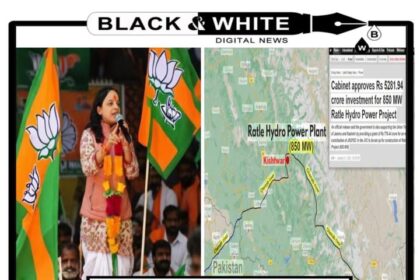NH-44: Kashmir’s Lifeline or Death Trap? A Saga of Flawed Vision, Failed Engineering, and Forgotten Accountability.
||Black and White Digital News||
||Tejveer Singh April 22,2025 ||
Srinagar-Jammu National Highway (NH-44)—touted as the lifeline of the Kashmir Valley—was envisioned as a triumph of modern infrastructure: an all-weather, four-lane expressway linking the region with the rest of India. Today, it stands instead as a cautionary tale—an unfinished promise buried under layers of landslides, tunnel collapses, washed-away roads, and mounting public frustration.
The story began in 2011 when the Government of India rolled out an ambitious highway upgradation plan for NH-44, responding to the pressing need for uninterrupted connectivity for trade, tourism, defense logistics, and civilian mobility. Detailed Project Reports (DPRs) were drawn up, construction was divided into packages, and contractors were mobilized. From Kashmir to Jammu, bulldozers rolled out and hills were sliced open—but what was promised as a marvel of modern engineering gradually turned into a graveyard of misguided decisions.
The Kashmir-side upgrade was completed by 2017, involving a major realignment of nearly 80% of the original route. From Jammu, the stretch up to Udhampur and the now-renowned Dr. Syama Prasad Mookerjee Tunnel (Chenani-Nashri) brought momentary relief and hope. But once the work entered the treacherous terrain of Ramban and Banihal, nature began to fight back—and the fight, it seems, is far from over.
Anatomy of a Disaster:
At the heart of NH-44’s repeated failures lies a chilling reality: engineering without environmental empathy. The initial DPR for the Ramban-Banihal stretch proposed vertical slope cutting along the existing alignment without comprehensive geotechnical studies. This negligence destabilized the already fragile mountains, leading to landslides of unprecedented frequency and intensity.
The consultant responsible was blacklisted, but the damage—geological and reputational—was done. With crumbling slopes and an eroded trust in the system, the government scrambled to course-correct. A new consultant was appointed, five tunnels were proposed, and a revised DPR—this time allegedly based on thorough studies—was approved.
But the revised plan, too, crumbles under the weight of reality.
In 2023, the much-anticipated Cafeteria Morh tunnel, built to bypass a notorious slide zone, collapsed mid-construction. Cracks appeared in the structure due to unstable geological formations. A canopy was proposed as an alternative but soon ran into similar hurdles.
By March 2025, persistent rain caused a section of road to sink, choking traffic down to a single lane. Experts argued that extending the Ramban viaduct could have been a more viable solution—but it was too late. The ghost of earlier mistakes had already begun haunting the present.
The latest landslide at Seri, Ramban, obliterated three years of slope protection work that included geomats, rock bolting, and mesh netting. The failure sparked outrage—was the work flawed, the DPR insufficient, or both?
Recurring Failures, Fatal Consequences:
From Kela Morh to Panthal, from Battery Chashma to Marog, the story is the same: collapsed canopies, shattered tunnels, vanished roads, and lost lives. In the latest spell of rain, the so-called “all-weather” highway turned into a cemetery of infrastructure, with vehicles tumbling into gorges and thousands stranded for hours, if not days.
The scale of devastation has raised questions no one wants to answer:
Why are freshly built sections collapsing?
Where are the accountability mechanisms?
How did flawed DPRs even get approved?
Why is public safety compromised after spending thousands of crores?
In Battery Chashma, entire sections of road have been washed away, transforming daily commutes into acts of survival. The so-called “safety measures” remain decorative and ineffective in the face of nature’s fury.
Public Fury, Institutional Apathy:
The people of Jammu and Kashmir are not just angry—they are disillusioned. NH-44, once a symbol of hope and prosperity, has become a recurring nightmare. They question the competence of consultants, the oversight of agencies, and the sincerity of the state in ensuring safe and sustainable infrastructure.
Even more infuriating is the decision by the Public Investment Board (PIB) to reject two proposed tunnel projects on NH-244 (Chenani–Anantnag), stating that NH-44 already ensures “adequate” year-round connectivity. In light of the current breakdowns, this rationale appears not just flawed but dangerously detached from reality.
The Way Forward: From Collapsing Roads to Responsible Governance:
The crisis demands more than lip service—it calls for a paradigm shift in infrastructure development, especially in ecologically sensitive zones like the Himalayas. A few critical steps include:
1. Comprehensive geotechnical and environmental studies before every major project.
2. Strict adherence to DPR specifications and real-time third-party monitoring.
3. Accountability frameworks that go beyond fines—ensuring criminal liability where negligence leads to death or injury.
4. Development of alternative routes to ease dependence on NH-44.
5. Creation of a specialized Himalayan Engineering Corps, trained to handle the unique geological conditions of the region.
A Dream Undone:
NH-44 was meant to be a gateway to prosperity, a conduit for culture, commerce, and connectivity. Instead, it now symbolizes shattered dreams, engineering arrogance, and bureaucratic apathy. What was once a vision of modern India now lies buried under layers of debris, awaiting either redemption or further ruin.
If the government truly intends to honour the lives lost and the crores spent, it must act—not with announcements, but with action rooted in responsibility, science, and foresight. Because every landslide on NH-44 isn’t just a geological event—it’s a collapse of public trust.
Leave a comment
You Might Also Like
Hindustan K Musalman Ko Bharat Mata Ki Jai Bolne Me Pareshani Kyu Hai Desh Bhakti Kese Sabit Karega BJP Spokesperson Rajni Sethi
Hindustan K Musalman Ko Bharat Mata Ki Jai Bolne Me Pareshani Kyu Hai Desh Bhakti Kese Sabit Karega BJP Spokesperson…
0 Min Read
Narendra Modi Ji Bangladesh Me Hindu Community K Logon Ko Zinda J@lay*@ Ja Raha Hai Unko Bacha Lo
Narendra Modi Ji Bangladesh Me Hindu Community K Logon Ko Zinda J@lay*@ Ja Raha Hai Unko Bacha Lo #SaveBangladeshiHindus #ProtectHinduLives…
0 Min Read
MLA Shagun Parihar Flags Security Concerns at Rattle Hydropower Project, Seeks Probe: No FIR Filed
MLA Shagun Parihar Flags Security Concerns at Rattle Hydropower Project, Seeks Probe: No FIR Filed ||Black and White Digital News…
4 Min Read
Former Punjab IGP Amar Singh Chahal Shoo**ts Himself After Alleged ₹8.1 Crore Cyber Fraud Loss
Former Punjab IGP Amar Singh Chahal Shoo**ts Himself After Alleged ₹8.1 Crore Cyber Fraud Loss #AmarSinghChahal #PunjabPolice #FormerIGP #CyberFraud #CyberCrime…
0 Min Read









